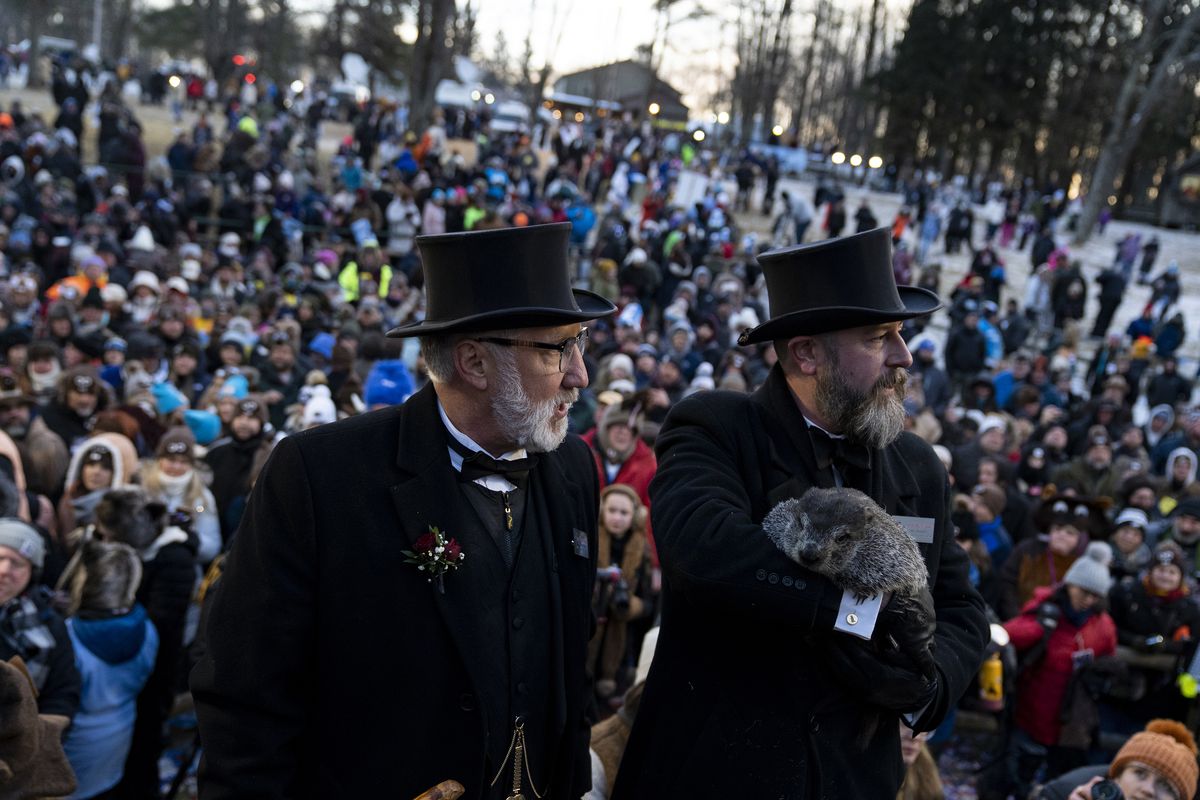Groundhog Day: Punxsutawney Phil predicts an early spring

PITTSBURGH — Punxsutawney Phil, Western Pennsylvania’s famed weather-predicting groundhog, predicted an early spring Friday morning after he emerged from his burrow and did not see his shadow.
The mystical marmot was summoned at dawn by the members of the Groundhog Club Inner Circle, a group of local dignitaries tasked with caring for Phil and organizing the annual Groundhog Day at Gobbler’s Knob — a small hill approximately 65 miles northeast of Pittsburgh.
Phil’s prediction comes as sunshine and temperatures in the 40s and 50s are expected for the week ahead, weather that Groundhog Day organizers said, in part, led to an estimated 30,000 visitors for the town’s festivities.
Phil’s forecast predicted six more weeks of winter the past three years after calling for an early spring in 2019 and 2020.
Here’s what you should know.
What are the origins of Groundhog Day?
The custom dates back to an early Christian tradition known as Candlemas, in which celebrants declared that clear skies on Candlemas meant a longer winter. Pennsylvania’s earliest settlers brought the tradition with them.
As for Phil, he rose to fame after appearing in Punxsutawney’s local newspaper in 1886. A member of a groundhog hunting group known as “The Punxsutawney Groundhog Club” used his clout at the paper to trumpet Phil, named after King Phillip, as the only official weather prognosticating groundhog.
Phil’s popularity grew from there, and the first of many annual Groundhog Day treks to Gobbler’s Knob followed in 1887.
Groundhog Day is led by the Groundhog Club’s Inner Circle, a group of 15 local dignitaries who also feed and take care of Phil year round, although the Inner Circle president is the only one responsible for translating Phil’s predictions.
Are Phil’s predictions foolproof?
Despite his induction into the Punxsutawney Weather Discovery Center’s Meteorologist Hall of Fame last year, Phil is not always spot-on in his predictions.
In fact, Phil’s Winter prognostications have been accurate just 39% of the time over 135 years, according to StormFax Weather Almanac.
Throughout the history of Groundhog Day, Phil has also been shown to be much more likely to predict six more weeks of winter.
He has seen his shadow 108 times while seeing no shadow 20 times.
There is no record of nine of his predictions during a span between 1889 and 1899, although it was reported that Phil did not see his shadow in 1890, predicting an early spring.
What does Phil do the rest of the year?
Although Groundhog Day brings the most visitors to Punxsutawney and the surrounding region, residents and Groundhog Day organizers said it’s not the only time to visit the small town of about 6,000.
However, anyone who wants to meet the meteorological mammal outside of Groundhog Day will have to visit him at his home, a climate-controlled burrow at the Punxsutawney Memorial Library.
Phil also travels to events across the country in either his handlers’ vehicles or his tricked-out Philmobile.
Meanwhile, when Phil isn’t meeting with fans, he’s snacking on kale, bananas, carrots, apples and sweet potatoes.
The holiday is a boon for the town and region
With Groundhog Day comes an influx of visitors and cash to Punxsutawney and the surrounding rural region.
Hotels across the region book up months in advance of the day and the visitors bring a much needed boost to local businesses during the traditionally slow month of January.
“It has a great impact on our local businesses,” Katie Laska, Punxsutawney Area Chamber of Commerce president and owner of Laska’s Pizza. “It’s the shot in the arm that we need every year.”
The effects also extend far past Punxsutawney into the entire region.
“Groundhog Day is a major asset not just for the town of Punxsutawney, but also for the PA Wilds region as a whole,” said Britt Madera, communications manager for the PA Wilds Center for Entrepreneurship, a nonprofit focused on conservation and economic development in the region. “When visitors come to see Phil make his annual prognostication, they’re often inspired to continue exploring other parts of the region too.”